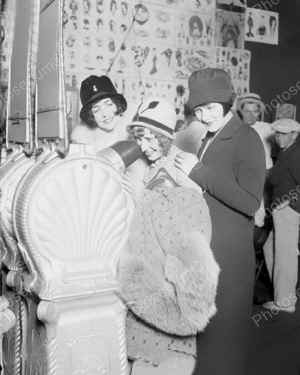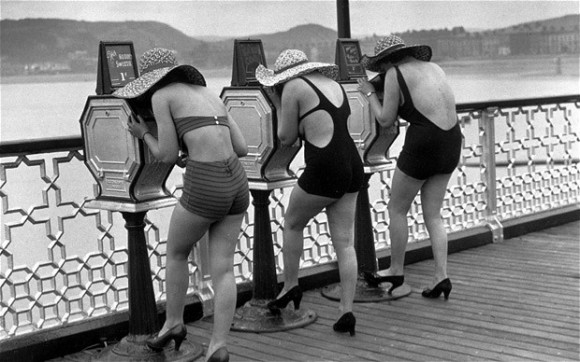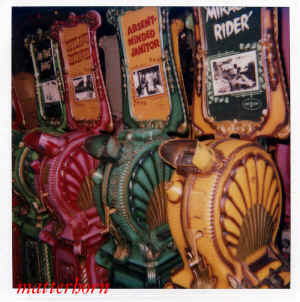|
Just One Peep Please
 The
Mutoscope was an early motion picture device. It was invented by Wm.
Laurie Dickson and Herman Casler, and patented by Herman Casler on
November 21, 1894. Like Thomas Edisonís Kinetoscope, it did not
project on a screen and provided viewing to only one person at a time.
Cheaper and simpler than the Kinetoscope, the Mutoscope, marketed by the
American Mutoscope Company, later the American Mutoscope and
Biograph Company, quickly dominated the coin-fed peep show business. The
Mutoscope was an early motion picture device. It was invented by Wm.
Laurie Dickson and Herman Casler, and patented by Herman Casler on
November 21, 1894. Like Thomas Edisonís Kinetoscope, it did not
project on a screen and provided viewing to only one person at a time.
Cheaper and simpler than the Kinetoscope, the Mutoscope, marketed by the
American Mutoscope Company, later the American Mutoscope and
Biograph Company, quickly dominated the coin-fed peep show business.
In about 1895 American Mutoscope and
Biograph Company began producing the coin operated picture movie
viewer. The earliest versions of the Mutoscope movie viewer were made of
wood in a very square looking box.
The Mutoscope worked on the same principle as the
flipbook. The individual image frames were conventional black-and-white,
silver-based photographic prints on tough, flexible opaque cards. Rather
than being bound into a booklet, like the flipbook, the cards were
attached to a circular core, quite like a huge Rolodex. A reel typically
held about 850 cards, giving a viewing time of about a minute.
Mutoscopes were coin-operated. The patron viewed the
cards through a single lens enclosed by a hood, similar to the viewing
hood of a stereoscope. The cards were generally lit electrically, but
the reel was driven by means of a geared-down hand crank. Each machine
held only a single reel and was dedicated to the presentation of a
single short subject, described by a poster affixed to the machine.
The patron could control the presentation speed only
to a limited degree. The crank could be turned in both directions, but
this did not reverse the playing of the reel. Nor could the patron
extend viewing time by stopping the crank because the flexible images
were bent into the proper viewing position by tension applied from
forward cranking. Stopping the crank reduced the forward tension on the
reels causing the reel to go backwards and the picture to move from the
viewing position; a spring in the mechanism turned off the light and in
some models brought down a shutter which completely blocked out the
picture.
Most actors appeared anonymously. Some reels were
made in series like Happy Hooligan, Rip Van Winkle, and Foxy
Grandpa. Single titles of some early reels were Alphonse and the
Gaston Helping Irishman, An Affair of Honor, Deaf Mute Girl Reciting the
Star Spangled Banner, How They Rob Men in Chicago, Babyís Day,
Robbed of Her All, Wake in Hellís Kitchen, and Old Maid and the
Burglar, all broad morality plays or comedies.
 By
about 1900, Mutoscope changed to a cast iron viewer, known as the
clamshell Mutoscope. This style of viewer was produced until about 1909,
when production halted. By
about 1900, Mutoscope changed to a cast iron viewer, known as the
clamshell Mutoscope. This style of viewer was produced until about 1909,
when production halted.
Bill Rabkin purchased the rights to manufacture
Mutoscope machines again, around 1926, and formed a new company called International
Mutoscope Reel Company. From about 1926 until 1949, they produced
Mutoscope machines using the same style card reels as the earlier
machines. These viewers were no longer cast iron, but used sheet metal,
and had an open frame or pedestal stand.
As far as Mutoscope movie reels go, the earlier
movies were generally the more spicy variety, sometimes with topless
women. When Rabkins bought Mutoscope, he largely policed himself and
didnít release movie reels with naked women, though many were close.
Rabkin did however play up the idea that the Mutoscope could be a peep
show viewer, using very racy and spicy titles. The movies themselves
never quite lived up to their titles. Other themes, like westerns and
sports and comedy were also popular. The whole peep show mentality is
what often kept Mutoscopes popular at arcades. The draw of new male
patrons to put their money into spicy Mutoscope titles such as, French
Dressing, X-Ray Gown, and Ladies Night in a Turkish Bath,
made it hard to resist.
Newsreels, sporting events, and Hollywood films were
cut by international Mutoscope, Co. to fit the one-minute viewing time.
Although there was no censorship board for Mutoscope reels like there
were for movies, the International Mutoscope Company made sure
that the morality squads, which were in vogue in those days, would not
attack the appropriateness of this type of entertainment.
 Mutoscopes
were a popular feature of amusement arcades and pleasure piers in the UK
until the introduction of decimal coinage in 1971. The coin mechanisms
were difficult to convert, and many machines were subsequently
destroyed; some were exported to Denmark where pornography had recently
been legalized. The typical arcade installation included multiple
machines offering a mixture of fare. Both in the early days and during
the revival, that mixture usually included "girlie" reels that
ran the gamut from risquť to outright soft-core pornography. It was,
however, common for these reels to have suggestive titles that implied
more than the reel actually delivered. The title of one such reel, What
the Butler Saw, became a by-word, and Mutoscopes are commonly known
in the UK as "What-the-Butler-Saw machines." What the
butler saw, presumably through a keyhole, was a woman partially
disrobing. Mutoscopes
were a popular feature of amusement arcades and pleasure piers in the UK
until the introduction of decimal coinage in 1971. The coin mechanisms
were difficult to convert, and many machines were subsequently
destroyed; some were exported to Denmark where pornography had recently
been legalized. The typical arcade installation included multiple
machines offering a mixture of fare. Both in the early days and during
the revival, that mixture usually included "girlie" reels that
ran the gamut from risquť to outright soft-core pornography. It was,
however, common for these reels to have suggestive titles that implied
more than the reel actually delivered. The title of one such reel, What
the Butler Saw, became a by-word, and Mutoscopes are commonly known
in the UK as "What-the-Butler-Saw machines." What the
butler saw, presumably through a keyhole, was a woman partially
disrobing.
There was also another style of Mutoscope called the
Mutoscope Selecto, available during the Bill Rabkinís era. This unit
allowed the player to select from five different movie reels on a single
Mutoscope unit. Unfortunately the movie reels for the Selecto are
smaller and "reversed" (the pictures would be backwards)
compared to the standard Mutoscope movie reel. The Selecto was a
marketing failure too, probably because of the non-interchangeable
reels. The Selecto machine also did not look like a standard Mutoscope
since it had a wooden case with a marquee that displayed the five
different movie titles.
The big problem with the Mutoscope was that only one
person could watch at a time. The promoters of the Mutoscope, the
K.M.C.D. Syndicate, tried to get around the issue by introducing
Mutoscope parlors that housed several such machines. There was no way
the machines could compete with the much more social and comfortable
environment of a seated audience watching projected film. The Syndicate
soon accepted this and introduced the Biograph, which enjoyed much
greater success.
Production of the Mutoscope reels ceased completely
in the 1950ís. Both the Mutoscope and the reels are highly sought
after by todayís collector and both fetch high prices.
|